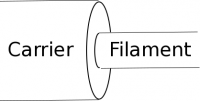Project 7
Project 7A: Lightbulbs'R'Us and JPL
You and your team are a group of electrical engineers working for Lightbulbs'R'Us. Given the problems that Lieutenant Pete “Maverick” Mitchell has been having with the warning lights, the Jet Propulsion Laboratory (JPL) Division of NASA has just called to place an large order for a new set of warning lights for their power delivery system. They have told you that a current of 2.5 A down the carrier wire should turn on the warning light. Unfortunately, due to JPL's time schedule, you do not have time to order LED bulbs and must construct the lightbulbs the old fashion way using a filament (very thin piece of wire, diameter = 0.1 mm) connected to the carrier wire (normal electrical wire, diameter = 1.63 mm). You happen to have the following metals in the warehouse, with known electron densities and electron mobilities. Which metals do you want to use for the carrier wire and for the filament? JPL would also be interested in knowing what kind of battery would be needed to power the lightbulbs and the electric field from the surface charges on your wires to make sure it doesn't interfere with their other equipment.
Project 7B:
The experimental aircraft that Lieutenant Pete “Maverick” Mitchell has been testing has been launched into outer space. The spaceship “Artemis 13” is currently hanging in lower Earth orbit. You and a team of scientists are testing the life support systems for extended space travel aboard the ship. During a training exercise, one of your fellow astronauts, Spurgeon Tanner, clutches at his chest and falls over. You, the talented Andrea Baker, recognize this immediately as a heart attack.
You go to the medical bay and grab the defibrillator and rush back to Spurgeon. When you go to charge the defibrillator, however, you notice that the instruments are not reporting a proper charge. In order to not risk the safety of your fellow astronaut by shocking him with faulty equipment, you decide against pressing the button and shouting “clear.” You need to save Spurgeon. Using your knowledge of electromagnetism, you know you can create a makeshift piece of equipment to be able to stabilize Spurgeon.
You go to the stock room downstairs only to discover that it isn't fully supplied yet. This was supposed to be just a simple systems test mission. You do find sheets of aluminum, and various paper sheets, some electrical tape and wires, a pair of all-purpose scissors, and a measuring tape.
The defibrillator must be able to deliver 360 J to Spurgeon in order to stabilize him. Can you fix the instrument and save the patient?
The paper sheets are 0.5 m wide, 2 m in length, and vary in thickness (2 mm, 1 mm, 500 $\mu$m, 50 $\mu$m, 1 $\mu$m, 0.5 $\mu$m). The aluminum sheets are 0.80 m in length, 0.5 m wide, and 0.3 mm in thickness. The defibrillator has a high voltage power supply of 30 kV.
